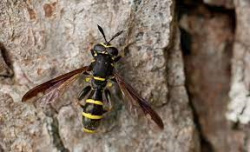Action Plans for conservation of threatened pollinator species in the EU
The International Union for Conservation of Nature (IUCN), in collaboration with experts from the IUCN Species Survival Commission, in particular the Invertebrate Conservation Committee and the Hoverfly Specialist Group, as well as Buglife, have started working on the production of Action Plans for conservation of threatened pollinator species in the EU.

Photo: Francesco Ungaro
The Action Plans are being developed in the framework of an EU funded contract which started in April 2021 and will run for two years. The work taps into an important IUCN knowledge product – it will follow the Guidelines for Species Conservation Planning (IUCN SSC 2017), developed by IUCN SSC Conservation Planning Specialist Group (CPSG). The group’s mission is to save threatened species by increasing the effectiveness of conservation efforts worldwide. The five first steps of the methodology will be applied to produce the final Conservation Action Plans for the European pollinators, as they embody the full planning stage: 1) Preparation, 2) Status Review, 3) Building a Vision and Goals, 4) Analysing Threats, setting objectives and performance indicators, and 5) Planning the actions.
Achievements so far
Experts have so far developed a shortlist of 15 candidate pollinators species for which action plans are needed in Europe. These options were proposed based on a set of criteria ranging from ecosystem fragility, biodiversity richness, species distribution in Member States, and potential for citizen science. The shortlist was discussed with a wider group of experts in June 2021 during an online workshop. As an outcome of this workshop, experts proposed three (multi-) species action plans to focus on as a priority. With the agreement of DG Environment, the following action plans were selected and will be prepared in the coming months:
- Canary Islands multi-species action plan
- Veteran Trees Specialist action plan
- Teasel multi-species action plan
The shortlist represents important areas for future work for conservation actions targeting EU pollinators.
1.The Canary Islands are a global hotspost of endemism characterised by diverse ecosystems. Tourism development, habitat destruction, wildfires and the introduction of invasive alien species are the main threats to local pollinators. Through stakeholder engagement and public participation, a successful action plan could address the main threats to these species.
 Sphiximorpha petronillae, Belgium
Photo: Frank Vassen
Sphiximorpha petronillae, Belgium
Photo: Frank Vassen
2. Sphiximorpha petronillae is a rare, wasp-mimicking hoverfly which relies on living veteran trees. These are usually removed and are rare in open habitats. Many saproxylic beetle species, which are also pollinators, require veteran trees as well. A multi-species action plan for pollinators that rely on veteran trees will establish important links with the forestry sector.
 Dasypoda hirtipes, Belgium
Photo: Henk Wallays
Dasypoda hirtipes, Belgium
Photo: Henk Wallays
3. Many wild bee species are highly specialised in pollen plants. This multi-species plan will focus on bee species which are specialised in teasel plants (Dipsacaceae), such as Scabiosa, Knautia etc. In addition to habitat conservation and restoration, this project may include reintroduction efforts in some EU Member States. Moreover, these species could be good for citizen science and public engagement as they are easy to identify and rely on teasel species which are recognisable plants across Europe.
Next steps – Workshops
The project experts will now work with conservation experts and practitioners, NGOs, government organisations and industry to develop the three action plans. Three dedicated workshops are planned to take place over the course of the next 12 months, to build a common vision and goals, analyse threats, set objectives, performance indicators, and plan concrete actions for each of the three groups of species.
The first workshop will be held in November 2021. It will focus on the Canary Islands multi-species action plan. Stakeholders will soon be invited to participate in this workshop and actively participate in the set up and implementation of the action plan.
For further info:
Aurore Trottet
Project Coordinator
aurore.trottet@iucn.org




